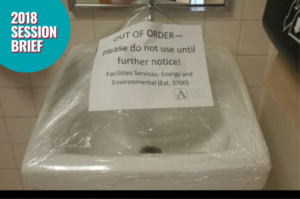By Alex Boss
 Not enough is being done in Georgia to remove lead from the water systems that run beneath schools and local communities. And a growing mistrust of the water supply could have a negative impact on other public health initiatives, like efforts to tackle the obesity epidemic.
Not enough is being done in Georgia to remove lead from the water systems that run beneath schools and local communities. And a growing mistrust of the water supply could have a negative impact on other public health initiatives, like efforts to tackle the obesity epidemic.
Those were some of the concerns raised by panelists during a session at the Oct. 18 State of the Public’s Health Conference at the University of Georgia. The panel focused on lead, an odorless hazard, that can negatively impact a child’s growth and development.
Journalists recapped an investigative report in which they not only found high amounts of lead in the water pipes of schools and other buildings statewide, but also very little oversight.
“There are a few states that require all schools’ drinking water and fountains to be tested for lead. Georgia is not one of them,” said Andy Miller, the editor and CEO of Georgia Health News.
A 2017 story Miller co-authored with Brenda Goodman, a WebMD senior news writer, said the current system leaves families in the Peach State “uninformed and unprotected.”
Meanwhile, UGA researchers said the poor water quality could also be a leaky valve in the nation’s attempt to address other public health concerns, like high obesity rates.
“The best practice we teach is to serve water indoors and outdoors and make it available as self-serve for our children,” said Caree Cotwright, an assistant professor in the College of Family and Consumer Sciences at UGA. But her team’s survey of childcare workers found fewer than 40 percent were providing water as the top alternative to sugary beverages like sodas.
“Something was going on,” Cotwright said. “Is it water mistrust?” Recent lead findings, she said, should raise alarm bells for many reasons.
For one, there is no safe level of lead in the blood of children, according to the Centers for Disease Control. Exposure to the metal can result in damage to the brain, slowed growth, and behavioral, speech and hearing issues.
Furthermore, it can be difficult to get to the root of the problem, as the symptoms of lead toxicity overlap with other conditions. “Lead poisoning in children can look like features on the autism spectrum,” Goodman explained.
At least four million households have children living in them that are being exposed to high levels of lead, the CDC estimates. According to the Environmental Protection Agency, a high-risk home is a home built before 1986 that has lead pipes. Other examples include homes with lead corrosion, where the metal from paint dissolves and leaks into the water supply.
The panelists are continuing to pursue research into the topic.
Cotwright, is planning to further study the cause for water mistrust among childcare providers. Her team wants to understand the factors that determine the choice of beverages served to children. She also believes that sharing tips on water safety and on how to properly test water for lead could help ease concerns for childcare professionals.
Miller and Goodman submitted the results of their lead investigation to the EPA, and the agency said it would begin conducting inspections and recording results more efficiently.
“We need to follow up on that,” Miller said.
In the meantime, Georgia Health News plans to look further into “hot spots” in the state, where test results have found high rates of children with too much lead in their blood to understand the reasons behind the statewide variations.
